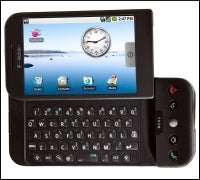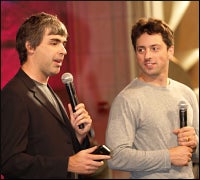 |
| The T-Mobile G1 Source: T-Mobile |
TheG1 Android smartphone has landed, with a boatload of buzz, an open source platform, a new application store, and even the founders of Google getting behind its launch into the marketplace.
At a splashy event here, T-Mobile unveiled the G1, the first smartphone on the market powered by the Google-backed Android operating system. The always-connected device features a slick design that borrows from the iPhone’s look and feel, as well as the popular pop-up keyboard feature of the T-Mobile Sidekick device.
But it’s the applications and the network speed that executives here touted, as well as a $179 price-point that could shake up the market.
“And most importantly, we’re going to embrace third parties to create new applications for the mobile Internet.”
Features in the G1 include built-in support for T-Mobile’s 3G and EDGE networks, as well as Wi-Fi compatibility. On the strength of those features, T-Mobile, Google and the G1’s manufacturer, HTC, are hoping their new entry can capture some buzz and market share from the current king of cool, Apple’s iPhone.
Additionally, the phone’s price, at $179 with a two-year contract, is bound to grab the attention of its rivals — at least the consumer-focused segment, which is where the phone is primarily aimed.
Andy Rubin, senior director of mobile platforms for Google, sees another strength for the G1 and other Android devices. Because the platform is open, “we think Android is somewhat future-proofed, because it has openness built in,” he said.
He added that it’s the “long tail” of the Android debut that’s the interesting component. By the long tail, he was referring Wired editor Chris Anderson’s theory that business models are moving toward niche-interest products and services — a concept that many point to as the reason for Internet retailer Amazon.com’s continued success.
Taking on iPhone
The T-Mobile G1 certainly has an iPhone look and feel, with dimensions of 4.60″ x 2.16″ x 0.62″ and weighing about 5.6 ounces. The display screen offers about 3.7 inches of real estate and also comes with a pop-up screen similar to the Sidekick. The G1 features built-in support for YouTube, and instant messaging clients Google Talk, AOL Instant Messenger, Windows Live and Yahoo Messenger.
During the launch event here, Google and T-Mobile executives touted the multiple ways users can interact with the device, such as its touch screen, pop-up QWERTY screen and the scroll ball — all at once, if need be.
Google and T-Mobile executives at the launch event here were quick to note that the open platform, along with its new application store, called Android Market, would be a compelling platform for developers to add new third-party applications.
Sung Hu Kim, a product marketing manager for Google, told InternetNews.com that third-party developers could get a license for Microsoft Exchange server in order to help users be able to sync with their Outlook contacts and calendar.
He said when the phone launches next month (Oct. 22nd), the applications on Android market can be found at shopsavvy.com, which features a bar code scanning feature that lets users compare prices in the store while shopping.
Another application store is called Ecorio, which helps people track their travels and view what their carbon footprints are. From there, built-in applications would enable them to trade in carbon units.
Another site in the Android store, Breadcrumbz, enables people to create visual maps using photos. Users can create their own routes and share those applications.
After a surprise visit by the Google’s founders, Larry Page and Sergey Brin, Google’s Rubin kept up the pitch to developers to embrace the open platform, as did T-Mobile’s Brodman.
 Larry Page and Sergey Brin made a surprise appearance at the G1 launch today, wearing roller blades to cope with New York traffic. Click to enlarge. Photo: Gene Hirschel |
Expect Android devices and their applications to geared toward consumers at first, Brodman said, but they hope to see some updates for business users.
That would help explain why there is no support for key applications such as Microsoft Exchange. But Rubin said the platform can read Microsoft (NASDAQ: MSFT) Word and Excel documents, and Adobe PDF files.
“There’s a great opportunity for third-party developers to bring Exchange components to the device.”
Google and its partners may have a good deal of work ahead of them if they seek to gain share in the workplace. A study released yesterday from J. Gold Associates predicted that Android would garner 4.8 percent of the business market during the next three years, while Apple’s (NASDAQ: AAPL) iPhone would claim a 16 percent share.
The firm also predicted that Research in Motion’s BlackBerry, which now holds 65.5 percent market share, will continue to dominate with a slightly lower 59.3 percent share.
At the same time, the big gainer may be Microsoft: J. Gold reported that it believes Windows Mobile’s share of the market will grow over the next three years, increasing from 22.5 percent to 28.6 percent.
Michael Gartenberg, vice president for mobile research for Mediabistro, gave today’s launch high points, but said it’s still missing some key features, especially for business users. (Mediabistro and InternetNews.com are owned by the same parent company, Jupitermedia Corp.)
“There’s no support for [Microsoft] Exchange server, and I can’t sync with iTunes or any of my music purchases,” he told InternetNews.com. “Not everyone uses Google services,” he said, referring to the built-in support for Gmail and other popular Google applications.
But overall, he counted himself as impressed with the features offered in the new device and where it’s driving mobile computing. The mobile phone is essentially where the PC was 15 years ago, he added, although it’s more than just sophisticated first-adopters now using these mini-computers. And, like the PC wars of 15 years ago, “the mobile operating system wars are in full swing.”
Article courtesy of InternetNews.com.


